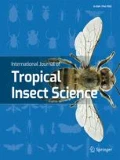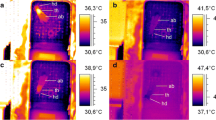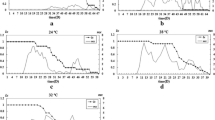Abstract
There were significant variations in oxygen consumption and carbon dioxide evolution of Macrotermes carbonarius (Hagen) among the soldiers and workers over a 10-hr experimental period. This suggested that the insects exhibited rhythmic respiratory behaviour in spite of being separated from their nest system and in the stressful situation of confinement of a respiratory flask at 29°C. The correlation between body fresh weight (mg) and respiratory rate ml O2/mg fresh wt/hr was significant. A respiratory quotient of 1.0–1.1 suggested that glucose was the respiratory metabolic substrate utilized and that both aerobic and anaerobic processes could have been taking place. Most of the leaf litter imported into the mound was utilized by the fungus on the fungus comb for metabolism with the release of carbon dioxide, heat and water. The heat released was sufficient to maintain the brood chamber temperature at 29.1 ± 03°C despite fluctuations of the ambient temperature and the temperature of the surrounding soil.
Résumé
Cette étude montre qu’il y avait des variations importantes dans l’ utilisation variation d’oxygène at l’évolution le gazearbonique parmi des soldatset des ouvriers de M. carbonarius dans une periode d’experimentation de dix heurs. Ce semble indiquer que les insectes se montrent une maniere respiratoire rhythmique malgré leur sepération de systeme de termitière. A 20°C le rapport entre le poids frais du corps (mg) et le taux de respiration rel O2/mg poids frais/hr était important. Un quotient respiratoire de (1.0–1.1) indique que le glucose était le substrat metabolique utilise et que les procès aerobique et anaerobique ont en lieu.
La plupart d’énergie de la litière de feuilles apportee dans le nid était utilisé par les fongussur le meule à champignons resultant en l’évolution de gaz carbonique, de la chaleur et de l’eau. La chaleur libere était suffisante pour maintenir la température de couver à 29.1 ± 0.2°C malgré les fluctuations de la temperature ambiente et de celle du sol environment.
Similar content being viewed by others
References
Abe, T. (1978) The role of termites in the breakdown of dead wood in the forest floor of Pasoh Study Area. Malay Nat. J. 30: 391–404.
Abe, T. (1979a) Studies on the distribution and ecological role of termites in a lowland rainforest of West Malaysia 2. Food and feeding habitats of termites in Pasoh Forest. Jpn. J. Ecol. 29: 121–135.
Abe, T. (1979b) Studies on the distribution and ecological role of termites in lowland rainforest 3. Distribution and abundance of termites in Pasoh Forest Reserve. Jpn. J. Ecol. 29: 337–351.
Abe, T. (1980) Studies on the distribution and ecological role of termites in a lowland rainforest of West Malaysia. 4. The role of termites in the process of wood decomposition in Pasoh Forest Reserve. Rev. Ecol. Biol. Sol. 17: 23–40.
Darlington J. P. E. C. ( 1984) A method for sampling populations of large termite nests. Ann. Appl. Biol. 104: 427–436.
Hardy, R. N. (1972) Temperature and Animal Life. Institute of Biology’s Studies in Biology No. 35, Edward Arnold Publishers, London.
Harper, H. A. (1973) Review of Physiological Chemistry. Large Medical Publishers, California.
Hébrant, F. (1970) Circadian rhythm of respiratory metabolism in whole colonies of the termites Cubitermes exiguus. J. Insect Physiol. 16: 1229–1235.
Ho, T. M. (1977) The biology of the termite Macrotermes carbonarius with respect to the foraging behaviour and aggression. M. Sc. Dissertation. Universiti Sains Malaysia.
Jander, R. and Daumer, K. (1974) Guideline and gravity of orientation of blind termites foraging in the open. Insectes Soc. 21: 45–69.
John, O. (1925) Termiten von Ceylon der Malayischen halbinisel. Sumatra, Java und den Aru-Inseln. Treubia, D, 360–419.
La Fage, J. P. and Nutting, W. C. (1979) Respiratory gas exchange in the dry wood termite Marginitermes hubbardi (Banks) (Isoptera: Kalotermitidae). Sociobiol. 4: 257–267.
Lee, K. and Wood, T. (1971) Termites and Soils. Academic Press, London and New York.
Luscher, M. (1962) Air-conditioned termite nests. Sci. Am. 205: 138–145.
Matsumoto, T. (1976) The role of termites in an Equatorial Rainforest of West Malaysia 1. Population density; biomass, carbon, nitrogen and calorific content and respiratory rate. Oecologia (Berlin) 22: 153–178.
Matsumoto, T. and Abe, T. (1979) The role of termites in an equatorial rainforest of West Malaysia II. Leaf litter. Consumption on the forest floors. Oecologia (Berlin) 38: 261–274.
McComie, L. D. (1981) An ecological study of Macrotermes carbonarius (Hagen) (Insecta, Termitidae, Macrotermitinae). M.Sc. thesis. Universiti Sains Malaysia, Malaysia.
Peakin, G. J. and Josens, P. G. (1978) Respiration and energy flow. In Production Ecology of Ants and Termites (Edited by Brian M. V.), pp. 111–163.
Rohrmann, G. F. (1977) Biomass, distribution and respiration of colony components of Macrotermes ukuzii Fuller (Isoptera, Termitidae, Macrotermitinae). Sociobiol. 2: 283–293.
Rohrmann, G. F. (1978) The original, structure and nutritional importance of the comb in two species of Macrotermitinae (Insecta, Isoptera). Pedobiologia 18: 89–98.
Roonwal, M. L. (1969) Termites of the oriental region. In Biology of Termites (Edited by Krishna, K. and Weesner F. M.), Vol. 11, pp. 315–384. Academic Press, New York and London.
Sands, W. A. (1969) The association of termites and fungi. In Biology of Termites (Edited by Krishna, K. and Weesner F.). Vol. I, pp. 495–524. Academic Press, New York and London.
Sands, W. A. (1972) Problems in attempting to sample tropical subterranean termite populations. Ecologia Polska 20: 23–31.
Umbriet, W. W., Burris, R. R. and Stauffer, J. F. (1972) Manometric Techniques. Fifth edition. Burges Publishing, Co., Minneapolis.
Watson, J. P. (1972) Some observations on the water relations of mounds of Macrotermes natalensis (Haveland). Insectes Soc. 19: 87–93.
Wood, T. G. and Sands, W. A. (1978) The role of termites in ecosystems. In Production Ecology of Ants and Termites (Edited by Brian M. V.), pp. 245–292, IBP Handbook 13, Cambridge University Press.
Zar, J. H. (1974) Biostatistical Analysis, First Edition. Prentice Hall, New Jersey.
Author information
Authors and Affiliations
Rights and permissions
About this article
Cite this article
McComie, L.D., Dhanarajan, G. Respiratory Rate and Energy Utilization by Macrotermes Carbonarius Hagen) (Isoptera, Termitidae, Macrotermitinae) in Penang, Malaysia. Int J Trop Insect Sci 11, 197–204 (1990). https://doi.org/10.1017/S1742758400010572
Received:
Revised:
Published:
Issue Date:
DOI: https://doi.org/10.1017/S1742758400010572
Key Words
- Macrotermes carbonarius
- respiratory rate
- oxygen consumption
- carbon dioxide liberation
- heat production
- water production
- oxidation of glucose
- mound temperature




